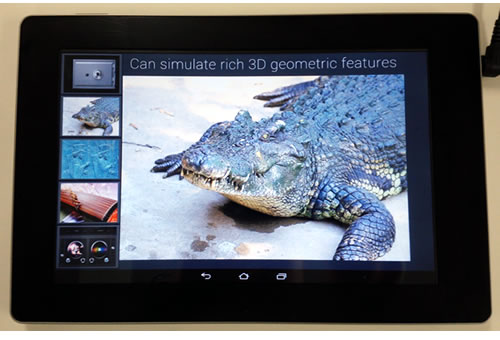Fujitsu Made a Haptic Sensory Prototype Tablet
This tablet provides the sensation of smooth and rough using vibrations.
Fujitsu Laboratories revealed last week that it has developed the industry's first technology to use ultrasonic vibrations to convey tactile sensations. This is achieved by varying the friction between the touchscreen display and the user's finger. This method enables the sensation of smooth or rough right on the display surface.
Fujitsu explains that by inducing an ultrasonic vibration on the surface of the touchscreen, a high-pressure layer of air is created between the screen's surface and the user's fingertip. This method reduces friction, thus creating a floating effect. Presumably, this effect would drain a device's battery, but that's not the case here, as the lab reports that it has developed a technology that induces vibrations efficiently at mobile device sizes.
For the sensation of roughness, Fujitsu Labs' tech rapidly cycles between high and low friction in response to touch information on the panel and the screen's display information. "This technology can generate a tactile illusion that the screen is bumpy or rough," Fujitsu Labs explains. "The combination of tactile information, visual information from the display, and audio information from the speakers enriches the user experience."
Both tactile techniques were added to a prototype tablet and displayed during Mobile World Congress 2014 last week. One demo allowed users to strum the strings of a koto, a traditional Japanese harp. Other demos allowed users to move a CD placed on a mixing deck, and to feel the rough skin of an alligator.
"By enabling more realistic and intuitive operability, the tactile sensory technology in this prototype has wide-ranging potential applications, including for electronic product catalogs, on tablets and other devices, as well as potential applications for a variety of services," Fujitsu Labs states.
Fujitsu and Fujitsu Laboratories are shooting for commercialization of this tech in fiscal 2015.
Our friends at Laptop Mag were able to go hands-on at MWC.
Get Tom's Hardware's best news and in-depth reviews, straight to your inbox.
Follow us @tomshardware, on Facebook and on Google+.

Kevin Parrish has over a decade of experience as a writer, editor, and product tester. His work focused on computer hardware, networking equipment, smartphones, tablets, gaming consoles, and other internet-connected devices. His work has appeared in Tom's Hardware, Tom's Guide, Maximum PC, Digital Trends, Android Authority, How-To Geek, Lifewire, and others.
-
Tuishimi This is very cool. I should think this might help open up a new online world for the blind.Reply -
Durandul This has applications beyond what I can even imagine. More useful than you or I can think of at this moment. It won't be revolutionary, but it will be helpful.Just for the sake of an example, one usecase would be making games more engaging. Let's say angry birds, (lord knows it's a pretty boring game) just add some feedback, a linear increase in friction as you draw back the slingshot with a sharp vibration when you hit the limit of the slingshot would provide a satisfying mechanic to an otherwise simple game.Reply -
vertigo_2000 I was thinking that just being able to create the feeling of buttons on a flat surface would help touchscreen keyboards.Reply -
RedJaron ReplyI was thinking that just being able to create the feeling of buttons on a flat surface would help touchscreen keyboards.
Precisely what I'm thinking. Tactile feedback on touchscreen displays would be huge. Make a touchscreen keyboard that can fully programmable, rearrange the keys and controls, and get a tactile sensation too? Could be really nice. -
southernshark it would be cool to create a virus that infects tablets and forces it to always be rough to the touch.Reply
